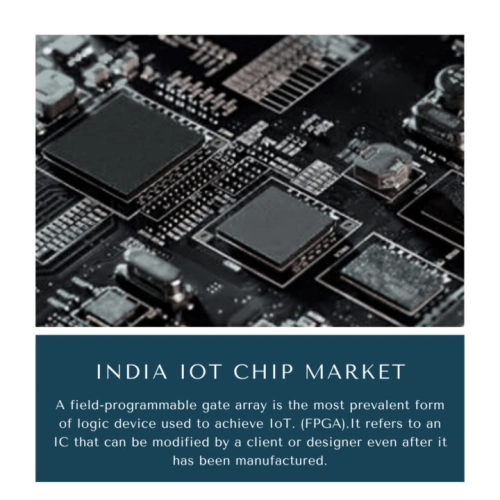
- Get in Touch with Us

Last Updated: Apr 25, 2025 | Study Period: 2024-2030
Due to the sheer growing adoption of the Internet of Things (IoT), the development of internet connectivity, the integration of connectivity in a large number of mobile devices and applications, and technological advancements in 5G networks, artificial intelligence, machine learning, smart homes, and smart cities, the Indian IoT chip market is expected to grow.

A field-programmable gate array is the most prevalent form of logic device used to achieve IoT. (FPGA). The term "field-programmable gate array" refers to an IC that can be modified by a client or designer even after it has been manufactured.
Hardware description languages, such as VHSIC Hardware Description Language (VHDL) or Verilog, are used to programme FPGAs.
Rapid development, reduced time-to-market, ability to reprogram in the field for debugging, and lengthy product life cycles are all advantages of FPGA. The increased demand for wearables is to blame for the considerable increase in logic device shipments.
The India IoT Chip Market accounted for $XX Billion in 2023 and is anticipated to reach $XX Billion by 2026, registering a CAGR of XX% from 2024 to 2030.
Cyient signs an agreement with IITH and WISig to manufacture 5G NB-IoT chips in India.
The Memorandum of Understanding they signed is in line with the Ministry of Electronics and Information Technology's (MeitY) aims of developing a thriving semiconductor design and creative ecosystem to help India become a worldwide powerhouse for electronics production and design.
The creation of packaging, a production test solution appropriate for volume production, the organisation of silicon manufacturing, volume testing of the IC, and the management of providing the chip will all be part of the volume production of the Koala chip.
| Sl no | Topic |
| 1 | Market Segmentation |
| 2 | Scope of the report |
| 3 | Abbreviations |
| 4 | Research Methodology |
| 5 | Executive Summary |
| 6 | Introduction |
| 7 | Insights from Industry stakeholders |
| 8 | Cost breakdown of Product by sub-components and average profit margin |
| 9 | Disruptive innovation in the Industry |
| 10 | Technology trends in the Industry |
| 11 | Consumer trends in the industry |
| 12 | Recent Production Milestones |
| 13 | Component Manufacturing in US, EU and China |
| 14 | COVID-19 impact on overall market |
| 15 | COVID-19 impact on Production of components |
| 16 | COVID-19 impact on Point of sale |
| 17 | Market Segmentation, Dynamics and Forecast by Geography, 2024-2030 |
| 18 | Market Segmentation, Dynamics and Forecast by Product Type, 2024-2030 |
| 19 | Market Segmentation, Dynamics and Forecast by Application, 2024-2030 |
| 20 | Market Segmentation, Dynamics and Forecast by End use, 2024-2030 |
| 21 | Product installation rate by OEM, 2023 |
| 22 | Incline/Decline in Average B-2-B selling price in past 5 years |
| 23 | Competition from substitute products |
| 24 | Gross margin and average profitability of suppliers |
| 25 | New product development in past 12 months |
| 26 | M&A in past 12 months |
| 27 | Growth strategy of leading players |
| 28 | Market share of vendors, 2023 |
| 29 | Company Profiles |
| 30 | Unmet needs and opportunity for new suppliers |
| 31 | Conclusion |
| 32 | Appendix |